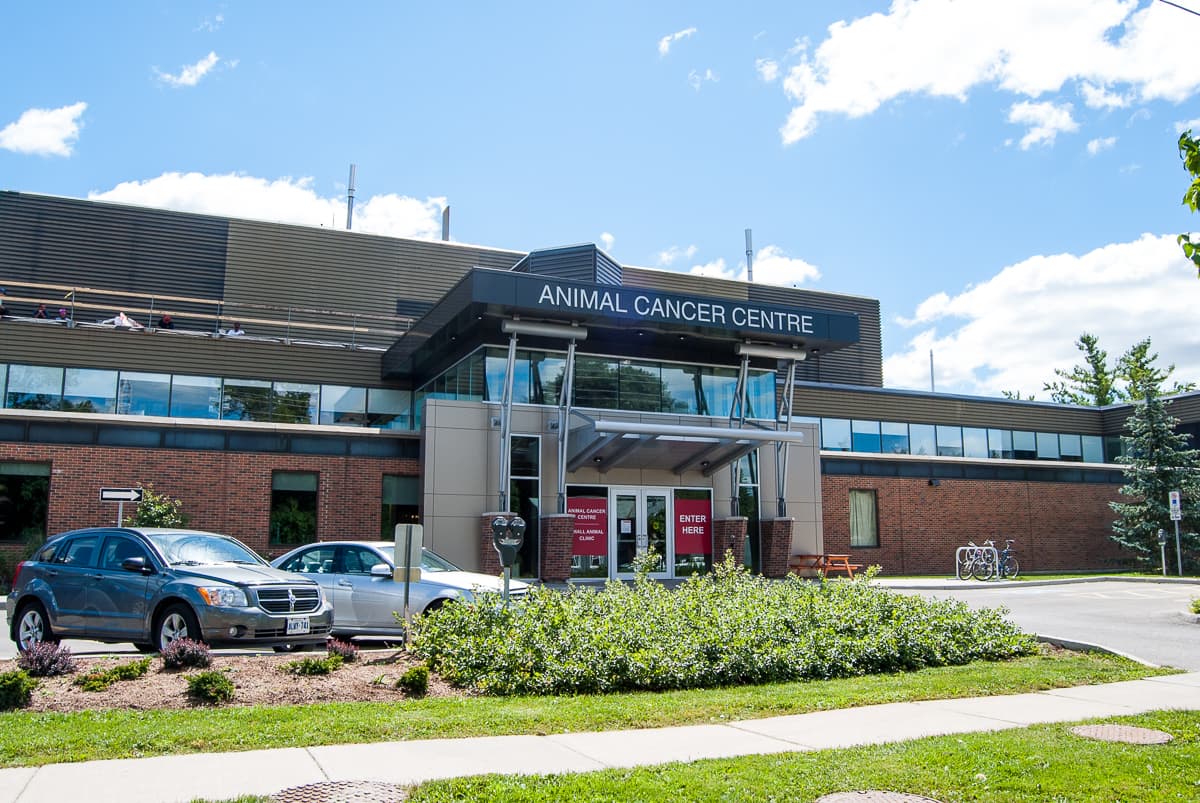Dr. Tony Mutsaer’s new melanoma treatment strategy could lead to better cancer outcomes for dogs diagnosed with canine melanoma.
What is Canine Melanoma?
 Canine melanoma is a type of cancerous tumour that affects dogs. These tumours are typically found in a dog’s mouth or nail beds but can appear anywhere on their body. It is a fairly common diagnosis, and many dogs are referred to the OVC Mona Campbell Centre for Animal Cancer each year to undergo specialized treatment. However, this cancer can spread very quickly, making it hard for veterinarians to treat.
Canine melanoma is a type of cancerous tumour that affects dogs. These tumours are typically found in a dog’s mouth or nail beds but can appear anywhere on their body. It is a fairly common diagnosis, and many dogs are referred to the OVC Mona Campbell Centre for Animal Cancer each year to undergo specialized treatment. However, this cancer can spread very quickly, making it hard for veterinarians to treat.
To tackle this pressing issue, a research team led by Dr. Anthony Mutsaers, veterinary oncologist, cancer researcher and associate professor at OVC, is studying this disease on a cellular level. His team’s goal is to improve treatment outcomes and extend the life expectancy of dogs diagnosed with melanoma.
“When people hear the word, ‘melanoma,’ the first thing that usually comes to mind is the type of skin cancer that people get from the sun, but dogs can get it too,” says Mutsaers. “It’s actually one of the most frequent causes of canine malignant oral tumours.”
In humans, melanoma is most often caused by sun damage and ultraviolet (UV) exposure, but this is not the case in dogs. The cause of canine melanoma is largely unknown — although the risk is higher in older dogs and among certain breeds, such as black labradors and chow chows.
The Problem: Canine Melanoma Can Easily Dodge Cancer Treatments
Human melanoma is highly curable if caught and treated early; however, canine melanoma is often diagnosed at a later stage, and behaves aggressively. This cancer can spread quickly into a dog’s lymph nodes, lungs and elsewhere, which makes treatments like chemotherapy (“chemo”), vaccination, radiation or surgery less effective. While all of these treatments may extend the lifespan of a dog with melanoma, this cancer is highly invasive, and survival rates are often low.
“Canine melanoma is notoriously very hard to treat because of how fast it spreads, and how resistant it is to chemo options,” says Mutsaers. “Even when veterinarians use a combination of treatments, the prognosis for canine melanoma is generally poor.”
Current treatment options target and kill rapidly dividing cancer cells, but they do not get to the root cause of the issue. In contrast, Mutsaers’ team is researching ways to prevent the tumour cells from growing and spreading, by using drugs that block cell signalling pathways.
How Do Cells Communicate?
Signalling pathways are a series of proteins inside the cell that help them communicate and function. Proteins on different parts of the cell called ‘receptors’ receive messages from other cells, or the environment, that tell the cell what to do. Once “turned on” by these messages, the signalling pathways start a series of chemical reactions within the cell, which are vital for cell growth and survival.
“I like to think of cell signalling pathways as an hourglass,” says Mutsaers. “You have lots of different inputs from the environment that bind to receptors on the cell. Then, these inputs get funneled through a narrow pathway and the result is a wide range of different outputs.”
In healthy tissues, these pathways are very important for normal function—for example, signalling pathways that instruct cells to repair themselves after an injury. But in cancer tumours, the pathways are ‘upregulated’, which means that they are working in excess, allowing cancer cells to divide, grow, thrive and spread faster than cells in healthy tissues.
“Since canine melanoma resists chemotherapy, we want to try to block the pathways that help the tumour grow and survive,” says Mutsaers. “My lab is researching this concept to better understand these cancer pathways and improve the way melanoma is treated.”
The Solution: Fighting Canine Melanoma Pathways Within the Cell
 A core pathway in canine melanoma tumour spread is called ‘mTOR/PI3K’; Mutsaers’ research team has been studying the impact of a drug treatment that blocks this pathway on cancer cell growth. In a recent lab study, they treated canine melanoma tumour cells with a combination of the common chemo drug, carboplatin, and an mTOR/PI3K inhibitor drug.
A core pathway in canine melanoma tumour spread is called ‘mTOR/PI3K’; Mutsaers’ research team has been studying the impact of a drug treatment that blocks this pathway on cancer cell growth. In a recent lab study, they treated canine melanoma tumour cells with a combination of the common chemo drug, carboplatin, and an mTOR/PI3K inhibitor drug.
“Carboplatin is the go-to chemo drug for melanoma cases in veterinary practice,” says Mutsaers. “We wanted to see if combining it with an mTOR/PI3K inhibitor drug would have any impact on the number of cancer cells that chemotherapy would kill on its own.”
Using lab-grown cancer cells, the team introduced different doses of each drug and used a scientific process called ‘flow cytometry’ to study the cells. They found that when the cells were treated with both drugs, the cancer cells were killed at a greater rate than if they were just treated with chemotherapy.
In 2021, this research was published in BMC Veterinary Research, and Mutsaers says that the improved chemo response they saw with these drugs points to a promising direction for the future of canine melanoma cancer treatment.
Next Steps: Testing Out New Melanoma Treatments in OVC Pets
Building on these early findings, Mutsaers’ team recently began a clinical trial with dogs referred to OVC for melanoma. They are studying the impacts of drugs called tyrosine kinase (TK) inhibitors, which block important receptors that utilize the mTOR/PI3K cancer pathway. These drugs have been used in the past to treat other types of canine cancers, but their use in melanoma has not been widely studied.
Owners can enroll their dogs into the trial if they have been diagnosed with canine melanoma—whether it has spread, or the tumour is contained to one spot. For information on the study, owners can visit the OVC Clinical Trials website.
Participating dogs will receive a TK inhibitor drug, and the research team will watch the tumour for several months to see if this treatment prevents it from growing and spreading.
“Our goal as a lab is to study the impact of these drugs on how melanoma tumours grow and change in the dogs that come into OVC,” says Mutsaers. “Since we saw a beneficial improvement with the pathway inhibitor drug in our lab study, this project gives us a chance to confirm our findings as we treat dogs with a TK inhibitor.”
Mutsaers says that OVC Pet Trust funding is fundamental to this work and in getting dogs with melanoma into the lab for treatment. Though the work is ongoing, Mutsaers says that the early results are an important starting place for future research on canine melanoma, and possibly other canine cancers. Ultimately, his team hopes to help get better melanoma treatments into veterinary offices, so dogs who are diagnosed have a better chance of surviving.
“Understanding how we can translate research findings to clinical results is at the crux of what we do, and getting this work into veterinary clinics is not easy,” says Mutsaers. “But our team is dedicated to finding a revolutionary treatment option for this aggressive and chemo-resistant cancer.”
Common Signs of Canine Melanoma to Watch For:
- A lump on your dog’s mouth, lips, tongue or gums*
- A lump or blister-like rash on your dog’s skin*
- Changes to your dog’s mouth or face structure (e.g., swelling, loose teeth or blood)
- Changes to your dog’s feet and toes (e.g., swelling, colour change or loose toenails)
*Some melanoma masses are dark or pigmented. Others lack pigment and appear as pinkish (similar to gum tissue) and are referred to as amelanotic melanoma.
If you notice any of these signs in your furry friend, contact your vet!
How do Traditional Treatments Work?
Veterinarians may use any of these treatments on canine melanoma:
- Chemotherapy: Medicine that causes cancer cells to stop growing and die.
- Radiation: A machine that delivers high-energy x-ray waves to a cancer tumour. These waves can damage and kill cancer cells to prevent the tumour from growing or spreading.
- Surgery: A veterinarian can remove the melanoma tumour and tissue from the areas around it via an operation.
- Melanoma Vaccine: This vaccine elicits a targeted immune response against cancerous melanoma cells but only works if the cancer has not spread to other parts of the body.
Written by Caitlin Ford
Pictured in this article: The OVC Mona Campbell Centre for Animal Cancer and Dr. Tony Mutsaers
This article was originally published in Best Friends magazine (Spring/Summer 2024)

